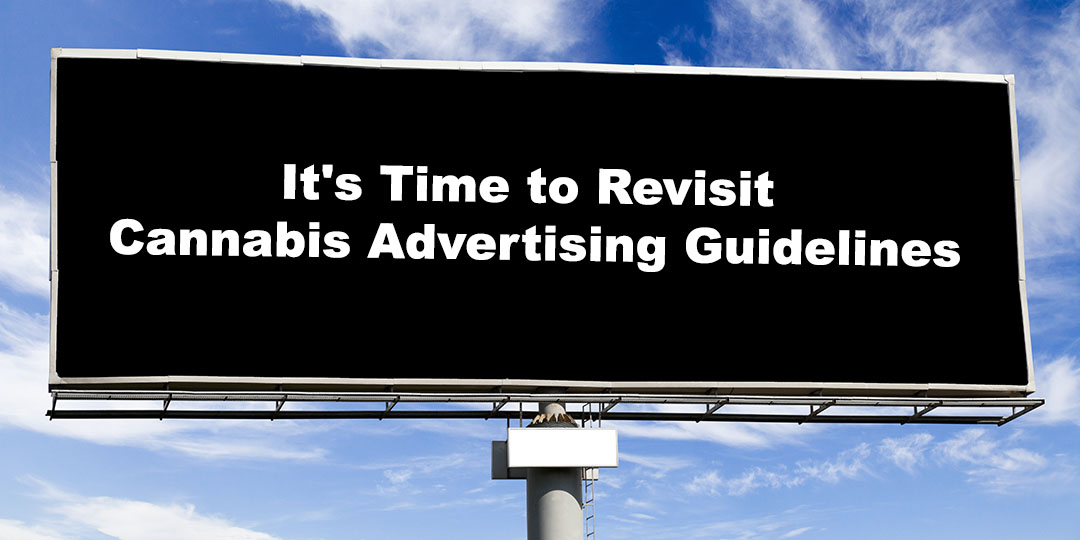It's Time to Revisit Cannabis Advertising Guidelines
Ecommerce & Retail
written by Brent Martino
As the cannabis industry continues to grow and evolve, it’s becoming increasingly clear that the current advertising guidelines are outdated and make it harder to compete. With over 300 cannabis retailers in Massachusetts alone, the competition is fierce. However, many dispensaries, especially smaller ones, are finding it nearly impossible to stand out due to restrictive advertising laws that don’t apply to their alcohol industry counterparts. It’s time to revisit these guidelines and bring them in line with alcohol advertising laws to create a fairer playing field.
Unfair Differences in Advertising Laws
One of the most glaring discrepancies between cannabis and alcohol advertising is the level of restriction imposed on cannabis businesses. While alcohol companies are allowed to advertise their products on TV, radio, and social media, cannabis businesses are often limited to online channels with strict age-gating requirements. Furthermore, alcohol brands can sponsor events, create branded merchandise, and engage in a wide range of promotional activities that cannabis companies simply cannot.
These limitations make it exceedingly difficult for cannabis businesses to reach their target audience. The inability to advertise on mainstream platforms restricts brand visibility, making it harder for consumers to discover new products or retailers. For smaller dispensaries without the budget to invest heavily in digital marketing, these restrictions can be particularly crippling.
The Prohibition on Advertising Sales and Specials
Another significant challenge facing cannabis businesses is the prohibition on advertising sales, deals, and specials. In a crowded marketplace where many retailers carry the same products, price and promotions are often the key differentiators. However, current regulations prevent cannabis companies from highlighting these aspects of their business, making it harder for them to attract cost-conscious consumers.
Why It’s Time for Change
The cannabis industry is no longer in its infancy. It’s a rapidly growing sector with immense economic potential, yet it’s still being treated with a level of caution that isn’t applied to other industries like alcohol. The restrictions on cannabis advertising are not only unfair but also counterproductive.
One of the key issues is the prohibition of advertising sales, deals, and specials. In the Massachusetts marketplace with over 300 cannabis retailers, many of whom carry the same products, the ability to differentiate is crucial. For alcohol, promotions and discounts are a common strategy to attract customers, yet cannabis businesses are denied this essential tool. This creates a significant disadvantage, particularly for smaller dispensaries that rely on competitive pricing and promotions to stand out.
These restrictions hinder the ability of cannabis businesses to communicate their unique value propositions to potential customers. For example, if a dispensary offers a special deal on a popular product, it should be able to advertise this promotion to attract new customers and retain existing ones. However, under the current guidelines, such advertising is prohibited, forcing dispensaries to find alternative, often less effective, ways to reach their audience.
The Impact on Smaller Dispensaries
The restrictive advertising laws disproportionately affect smaller cannabis businesses. Large, well-established brands may have the resources to build brand recognition through other means, such as extensive social media campaigns, influencer partnerships, or sponsorships. Larger dispensaries with more money behind them may even view potential fines as a cost of doing business so they can afford to take chances. Smaller dispensaries, however, often do not have the same financial bandwidth. They rely more heavily on traditional advertising methods, which are currently off-limits due to the stringent regulations.
Without the ability to advertise promotions, smaller dispensaries struggle to compete with larger, more established players. This not only stifles competition but also limits consumer choice. When new and innovative products or special deals cannot be advertised, consumers are less likely to discover them, leading to a less dynamic market.
Aligning Cannabis Advertising with Alcohol Laws
It’s time to reconsider the current approach to cannabis advertising and bring it in line with the more relaxed regulations governing alcohol. Alcohol brands have the freedom to advertise in a variety of formats, including television, radio, and social media, and they can promote sales and special offers without restriction. These opportunities should also be available to cannabis businesses.
By revisiting and revising the cannabis advertising guidelines, the industry can foster a more competitive and vibrant market. This would not only benefit businesses but also consumers, who would have greater access to information about products, deals, and promotions. Furthermore, aligning cannabis advertising laws with those of alcohol would reflect a more rational and fair approach to regulation, recognizing cannabis as a legitimate and mainstream industry.
Cannabis Advertising is Unfairly Restricted on Social Media
One of the major challenges facing cannabis businesses is the prohibition of advertising on major platforms like Google and social media channels such as Facebook and Instagram. These platforms have strict policies that prevent the promotion of cannabis products, even in states where cannabis is legal. This severely limits the ability of cannabis businesses to reach potential customers through some of the most widely used online advertising channels. Unlike alcohol brands, which can freely advertise their products on these platforms, cannabis companies must navigate a complex web of restrictions that often force them to rely on less effective and more costly advertising methods. This restriction is particularly burdensome for smaller dispensaries that do not have the resources to invest in alternative advertising strategies. The inability to leverage the broad reach of Google ads and social media not only stifles brand visibility but also makes it much harder for cannabis businesses to compete in an already crowded market.
In a world where social media is flooded with fake news, it’s puzzling that cannabis advertising is still off-limits. Misinformation spreads unchecked, causing real harm, yet platforms like Facebook, Instagram, and Google ban ads for a legal and regulated industry like cannabis.
This ban makes it tough for cannabis businesses, to reach customers and grow. Meanwhile, harmful content circulates freely. It’s time for these platforms to rethink their approach and allow responsible cannabis advertising, aligning with the industry’s push for legitimacy and transparency.
Conclusion
The cannabis industry has matured and deserves to be treated with the same respect and fairness as other industries, including alcohol. The current advertising restrictions are outdated and place an unnecessary burden on smaller dispensaries, making it difficult for them to compete. Revisiting and revising these guidelines to align with alcohol advertising laws would help level the playing field, encourage competition, and ultimately benefit consumers. It’s time for a change that reflects the true potential of the cannabis industry.
Crafting Cannabis Logos That Captivate: Expert Tips from Jade
Ecommerce & Retail
written by Lianne Santiago
In the fast-changing cannabis industry, a captivating logo is essential for brand success. A compelling logo reflects your brand’s values and differentiates you in a crowded market. As cannabis marketing experts, Jade offers valuable tips for creating a logo that truly reflects your brand’s identity and engages your target audience.
Understanding the Cannabis Market
Importance of a Strong Logo
A strong logo is the cornerstone of your brand identity, especially in the cannabis sector. It visually represents your brand’s values and mission, setting you apart in a competitive market. This is crucial in states with growing markets like Massachusetts, New Jersey, and New York. A unique logo attracts customers and builds brand loyalty, ensuring consistency across various channels. Investing in a well-designed logo is a strategic move to boost your brand’s success.
Key Elements of Effective Logos
Effective logos are simple, recognizable, and versatile across platforms. The right colors evoke emotions and match your brand’s identity, while typography should be readable and reflect your brand’s personality. Unique symbols or icons convey your cannabis business essence. Scalability ensures your logo looks great on both billboards and business cards. By focusing on these elements, you create a logo that stands out and communicates your brand’s values.
Researching Competitors
Researching competitors helps create a standout cannabis logo. Analyze leading brands to see what themes and elements resonate with consumers. Notice trends in color schemes, typography, and symbols. This research helps you avoid clichés and create a unique logo that captures your brand’s essence and appeals to your target audience.
Designing the Perfect Cannabis Logo
Reflecting Brand Values
Your logo should reflect your brand’s values, communicating what your brand stands for. Identify your core values and mission, and use elements that signify these values. A logo that reflects your brand’s values builds trust and loyalty among consumers and ensures consistency across marketing efforts.
Choosing the Right Colors
Choosing the right colors for your logo is crucial to conveying your brand’s message. Colors have psychological impacts and influence perceptions. Green often symbolizes nature and tranquility, while blues convey trust and professionalism. Select a color palette that aligns with your brand values and appeals to your audience.
Typography and Iconography
Typography and iconography are key in designing a captivating logo. Choose a font that reflects your brand’s personality and is readable across mediums. Icons further enhance your logo’s ability to communicate your brand’s essence. Harmonizing typography and iconography creates a logo that is visually appealing and representative of your brand.
Implementation and Beyond
Consistency Across Platforms
Consistency is key to building a recognizable cannabis brand. Ensure your logo looks the same across all marketing channels, including your website, social media, email campaigns, and packaging. Use brand guidelines to specify logo usage in different contexts, maintaining a cohesive look and reinforcing brand recognition.
Adapting Logos for Different Media
Adapting your logo for different media is important for effective brand implementation. Your logo must work across formats, from digital screens to printed materials. Use vector formats for quality and scalability, and create variations for different applications. This adaptability ensures a consistent and professional representation of your brand.
Working with a Cannabis Marketing Agency
Working with a cannabis marketing agency enhances your branding efforts. Agencies with cannabis marketing expertise understand market challenges and regulations. They can provide comprehensive marketing plans, including logo design and SEO. Collaborating with experts ensures a more compelling and compliant logo, setting your brand up for long-term success.
Bold Moves in Cannabis Marketing: How Target Audience Insights Drive Results
Ecommerce & Retail
written by Lianne Santiago
Knowing your target audience is essential in cannabis marketing. Using customer insights, brands can create effective campaigns that truly connect. This guide shows how audience insights can elevate your cannabis promotion with bold, lasting strategies.
Understanding Your Target Audience
Importance of Cannabis Consumer Insights
Cannabis consumer insights are crucial for effective marketing. These insights reveal who your customers are, what they like, and their behaviors. Tailoring strategies to these insights boosts engagement, conversion rates, and loyalty. They also help spot trends and market changes, keeping businesses competitive.
Identifying Key Demographics
Identifying key demographics is crucial in cannabis marketing. Factors like age, gender, income, and location provide a basic understanding of your customers. For instance, Millennials and Gen Z might prefer edibles and vapes, while Baby Boomers may prefer traditional forms like flowers. Knowing income levels helps set appropriate price points and promotions. Location insights inform location-based strategies.
Analyzing Consumer Behavior
Analyzing consumer behavior is essential in cannabis marketing. This includes understanding how customers interact with your brand, their buying patterns, and their preferences. Tools like surveys, analytics, and sales data provide deeper insights. This information helps craft tailored messages, optimize products, and improve satisfaction.
Strategies for Effective Cannabis Marketing
Crafting Targeted Campaigns
Crafting targeted campaigns is key to effective marketing. Using consumer insights, businesses can develop campaigns that meet audience needs. Segmenting your audience by demographics and behaviors enables personalized messages. Data from past campaigns can refine your approach, ensuring higher engagement.
Leveraging Digital Channels
Using digital channels is a strong strategy in cannabis marketing. Platforms like social media, email, and search engines offer unique ways to engage with your audience. Instagram and Twitter can showcase products and share useful content, while email marketing offers personalized promotions.
Utilizing Data-Driven Insights
Using data-driven insights is crucial for effective strategies. Analytics tools, surveys, and market research provide a clear picture of what your audience likes. Analyzing this data helps in product development, pricing, and promotions.
Maximizing Results in Cannabis Business Promotion
Measuring Campaign Success
Measuring campaign success is crucial for refining strategies and ensuring growth. Set clear goals for each campaign, like increased traffic or sales. Use analytics to track KPIs like click-through rates and conversion rates. Review data regularly to spot trends and make data-driven decisions.
Adapting to Market Trends
Adapting to market trends is essential for achieving results. The cannabis industry constantly changes, and staying updated on trends keeps your business competitive. Use market research and social listening to track consumer behavior, product popularity, and regulatory changes.
Building Long-Term Relationships
Building long-term relationships with customers is key for lasting success. Loyalty and trust drive repeat business and brand advocacy. Provide great service and high-quality products. Engage customers with personalized marketing, like tailored emails and exclusive promotions. A loyalty program rewards dedicated customers.
Cannabis Email and SMS Marketing: Strategies for Success in 2024
Ecommerce & Retail
written by Agatha Capriles
In the ever-changing cannabis industry, smart marketing is crucial to stand out. As we look towards 2024, mastering Cannabis Email and SMS Marketing is key for boosting your brand and connecting with customers. With the right approach, these channels can greatly improve your reach, build customer loyalty, and increase sales. This guide explores proven strategies and tips for crafting messages that resonate with your audience.
Mastering Cannabis Email Marketing
Building a Compelling Subscriber List
First, a strong subscriber list is essential. Offer value to potential subscribers through exclusive discounts, early access to products, or educational content. Use your website, social media, and in-store promotions to gather email addresses. Ensure you follow legal requirements and get clear consent. Segment your list based on customer preferences and behaviors to tailor your messages. A well-segmented list boosts engagement and conversion rates, driving your brand’s growth in 2024.
Crafting Engaging Email Content
Engaging email content is crucial. Start with a catchy subject line. Keep your content clear, short, and visually appealing. Use high-quality images and graphics. Add personalized touches like the recipient’s name and custom recommendations. Highlight key points with bold headings and bullet points. Always include a clear call-to-action (CTA). Avoid being overly promotional; focus on offering value. This approach builds stronger connections and drives conversions.
Analyzing Email Campaign Performance
Tracking metrics like open rates, click-through rates (CTR), conversion rates, and unsubscribe rates is key. Use this data to spot trends and improve your strategy. A/B test variables like design, copy, and send times. Listen to subscriber feedback to understand their needs. Regular analysis helps you make informed decisions, ensuring your messages are impactful and aligned with your audience’s interests.
Optimizing Cannabis SMS Marketing
Effective SMS Campaign Strategies
Clear consent from your audience is a must. Keep messages short and to the point. Personalize content to make it relevant. Use SMS for time-sensitive information like flash sales, event reminders, or exclusive promotions. Include a clear CTA. Send messages when recipients are most likely to engage. Segment your audience based on preferences and behaviors. These strategies will engage more customers, build loyalty, and help your brand grow.
Personalization for Higher Engagement
Use the recipient’s name to build familiarity. Send tailored offers and recommendations based on customer preferences and purchase history. Timing is important; send messages based on past actions. Ensure your content is relevant and valuable. Personalized messages are more likely to be opened and acted upon, leading to higher engagement and conversion rates.
Compliance and Best Practices
Understand the legal requirements for SMS marketing in your area. Get clear consent from recipients and offer an easy opt-out option. Follow rules like the Telephone Consumer Protection Act (TCPA) to avoid fines. Be transparent about what messages recipients will receive and how often. Don’t send messages too frequently. Ensure your content meets industry standards and regularly clean your contact lists to remove inactive numbers. Following these guidelines builds trust and ensures your campaigns are effective and well-received.
Need help with your cannabis company’s email and SMS marketing? Contact Jade for expert assistance in crafting effective and compliant marketing strategies that drive results. Reach out today to elevate your brand and connect with your audience!
5 Ways to Advertise Your Dispensary While Remaining Compliant
Ecommerce & Retail
written by Brent Martino
Advertising in the cannabis industry requires navigating strict regulations to ensure compliance. The Massachusetts Cannabis Control Commission (CCC) has specific rules that dispensaries must follow to avoid penalties. Here are five effective ways to advertise your dispensary while staying within legal boundaries.
1. Leverage Personalized Communications
Personalized communications are a powerful tool for dispensaries. They are directed at specific individuals who have opted in to receive information, thus not falling under the broad advertising restrictions.
Email Marketing:
Build an email list of customers who have opted in to receive updates from your dispensary. Use these emails to share news, product information, and special offers. Ensure that every email includes the necessary health warnings and disclaimers as required by the CCC regulations.
In-Store Promotions:
Inform customers directly when they visit your store about promotions. This can be done through discussions with budtenders or with in-store signage. By keeping these promotions in-store, you avoid the broad advertising restrictions that apply to online or third-party advertisements.
2. Optimize Your Website for Local SEO
Enhancing your online presence through local SEO can help attract customers without violating advertising regulations. Focus on creating valuable, informative content highlighting your dispensary’s offerings and expertise.
Local Keywords:
Use local keywords such as “Worcester dispensary” or “Massachusetts cannabis store” to attract local traffic. Ensure these keywords are naturally integrated into your website content, meta descriptions, and headers.
Google My Business:
Optimize your Google My Business profile with accurate information, including your address, hours of operation, and contact details. Encourage satisfied customers to leave positive reviews, boosting your local SEO and attracting more foot traffic.
3. Educational Content Marketing
Create and share educational content that provides value to your audience. This will not only position your dispensary as an authority in the cannabis industry but also help you comply with advertising regulations.
Blog Posts and Articles:
Write blog posts and articles about topics such as cannabis strains, usage methods, and the benefits of different products. Avoid direct promotions and instead focus on providing informative and educational content. Be sure to include calls to action and links to your menu. Blog posts are also an excellent way to assist with search engine rankings, as they offer fresh, keyword-rich content.
Social Media:
While direct advertising of discounts and promotions is restricted, you can use social media to share educational content. Post about industry news, responsible usage, and educational content. Ensure your social media profiles are age-gated to prevent underage access.
4. Community Engagement and Events
Engaging with the local community through events and sponsorships effectively promotes your dispensary without violating advertising rules.
Community Events:
Participate in or sponsor local community events. These events provide an opportunity to connect with potential customers in a compliant manner. Ensure that any promotional materials distributed at these events adhere to CCC regulations.
Workshops and Seminars:
Host educational workshops and seminars on cannabis-related topics. This will position your dispensary as a knowledgeable resource and build trust within the community.
5. Compliant In-Store Advertising
In-store advertising can effectively promote products and specials without breaching CCC guidelines.
Digital Signage:
Use digital screens within your dispensary to showcase product information, educational content, and bundles. Since this advertising is confined to your store, it does not fall under the broad advertising restrictions.
Printed Materials:
Distribute printed materials, such as brochures and flyers, within your dispensary. Ensure that these materials include all required health warnings and disclaimers.
Budtender Engagement:
Budtenders play a crucial role in in-store advertising. They are the frontline communicators who interact directly with customers, providing personalized recommendations and information about promotions. Well-trained budtenders can enhance customer experience by sharing detailed knowledge about products, answering questions, and informing customers of in-store special offers. Their ability to build customer relationships and trust can significantly influence purchasing decisions and promote customer loyalty.
Conclusion
Navigating the advertising regulations for cannabis dispensaries in Massachusetts can be challenging. Still, you can effectively promote your dispensary while remaining compliant with CCC guidelines by leveraging personalized communications, optimizing for local SEO, creating educational content, engaging with the community, and utilizing in-store advertising. Always stay informed about the latest regulations and consider consulting with legal experts to ensure your advertising strategies are fully compliant.
If you need help understanding these complex regulations and optimizing your cannabis marketing strategy, contact Jade, your trusted cannabis marketing agency. Let us help you navigate the regulatory landscape and grow your business.
Choosing the Ideal Email Marketing Platform for Your Business: A Detailed Examination of Klaviyo, Constant Contact, and Mailchimp
Ecommerce & Retail
written by Jasmine Cordeiro
Are you looking for a reliable email marketing platform tailored to your business needs? In this deep dive, we’ll examine and discuss the leading platforms: Klaviyo, Constant Contact, and Mailchimp. Our expert analysis will point you to the right platform, whether you’re an experienced professional or a budding entrepreneur. Reach out to us today to explore the platform that can elevate your business growth!
Understanding Email Marketing Platforms
What Makes an Exceptional Email Marketing Platform?
In a digitally inclined world, the right email marketing platform can be a game-changer. But what exactly makes a platform exceptional? Foremost, simplicity is vital – a user-friendly platform streamlines processes and minimizes frustration. Secondly, the platform should offer customizable templates in order to mirror your brand’s identity and messaging.
Also, it should present precise analytics and tracking features. Knowing who opens your emails, when, and what they interact with can benefit campaign optimization. Automation is a crucial feature that enables you to create a string of emails for repeat audience engagement.
Lastly, an ideal platform guarantees high email deliverability, making sure your emails reach your recipients. Equipped with these features, a platform can bolster your email marketing, connecting you with your audience seamlessly and effectively.
The Imperative of Personalized Email Campaigns
Tailored email campaigns are not an option anymore—they’re mandatory. In this digital era, consumers are overwhelmed with marketing communications. To grab their attention your messages need to be relevant and exclusive.
However, building personalized email campaigns can be intricate. It demands an in-depth understanding of your audience and ability to analyze and apply customer data. Here’s where a robust email marketing platform steps in. By opting for a platform that facilitates personalization, you can design effective, targeted campaigns that strike a chord with your audience.
Klaviyo – The Analytical Perspective
In-depth Analytics and Segmentation
In email marketing, data is crucial. Klaviyo, a data-oriented platform, delivers quality analytics and segmentation tools that enable you to comprehend your audience and boost your marketing initiatives.
Klaviyo’s analytics feature provides a detailed view of your campaign’s performance, ensuring data-driven email marketing. It’s automation and integration capabilities make it a vital tool for effective, custom-made, and data-driven email campaigns.
Constant Contact – The User-friendly Colossus
Effortless Email Marketing for Beginners and Small Businesses
While Constant Contact’s pleasing and easy-to-use interface makes it a hit amongst beginners or those preferring a simple platform, it does have its limits, especially with personalization. Yet, its simplicity should not be underestimated. For businesses seeking straightforward email marketing solutions, Constant Contact provides a reliable, easy-to-navigate platform that consistently achieves solid results.
Mailchimp – The All-Inclusive Marketing Solution
Comprehensive Marketing Platform
Mailchimp has carved its niche in email marketing platforms, largely due to its integrated approach, offering a complete marketing solution. However, careful consideration of its potential shortcomings, including list building & segmentation, is a must to decide if Mailchimp is the right fit for your business.
Determining the Best Platform for Your Business
Balancing Needs with Features
When choosing the optimal email marketing platform for your business, it’s crucial to compare your distinct needs with the features of each platform. After all, there’s no one-size-fits-all. The best platform should be able to accommodate your business’s evolving needs, driving continual success.
Reach out to us today to select the email marketing platform that aligns with your business needs and escalates your growth.
The Art of Rebranding: Understanding the Information Clients Should Share with their Creative Team
Ecommerce & Retail
written by Isabella Trejo
The Necessity of Rebranding
Rebranding is more than just a facelift for a company’s image; it’s a strategic move that often reflects deeper changes in a business. As markets evolve, staying relevant is not optional—it’s imperative for survival. Companies may find that their current brand no longer represents who they are or fails to resonate with a new generation of consumers. Disruption caused by technology, changes in consumer behavior, or a shift in company direction can all trigger the need for a rebrand. Moreover, a rebrand can be a decisive response to competitive pressure or a way to distance a company from negative associations. It’s about ensuring that the brand’s identity, message, and values are aligned and can effectively connect with the target audience. In essence, rebranding is not just about change; it’s about strategic evolution and maintaining a competitive edge in a dynamic market.
Key Elements of Successful Rebranding
A successful rebrand hinges on a few critical elements. First and foremost is a clear vision that guides the rebranding process. This vision should reflect the company’s future direction and how it wants to be perceived. Secondly, consistency across all touchpoints is crucial. From the logo to the website, social media, and packaging, every element must tell a cohesive story. Thirdly, understanding and retaining the core values that customers cherish about the brand is essential while also making room for innovation. Another key element is engaging stakeholders throughout the process, including employees, customers, and partners, ensuring their buy-in and support. Lastly, a successful rebrand requires thorough market research to understand the competitive landscape and identify opportunities. It is the blend of these strategic components that can transform a rebranding effort from a mere change in aesthetics to a powerful business growth strategy.
Essentials Clients Should Share
Clients embarking on a rebrand must share comprehensive information to ensure the creative team can deliver results that resonate. This includes the brand’s history, highlighting past successes and areas for improvement. A detailed analysis of the target audience is also essential, providing insights into their preferences, behaviors, and trends. Clients should articulate their unique value proposition clearly and explain how it sets them apart from the competition. Additionally, a candid discussion about the reasons for rebranding helps the creative team understand the urgency and the goals. Sharing any existing customer feedback can offer valuable perspectives on the brand’s current market position. Moreover, the client’s vision for the future, including any planned expansions or shifts in strategy, must be communicated. When clients provide this essential information, it not only informs the rebranding strategy but also fosters a collaborative and transparent relationship with the creative team.
Maintaining Open Communication with the Creative Team
Open communication is the lifeblood of a successful rebranding initiative. Clients should maintain an ongoing dialogue with their creative team, providing feedback and being receptive to new ideas. It’s important to establish regular check-ins where updates are shared, and milestones are reviewed. This helps in tracking progress and ensuring that the rebrand stays true to the client’s vision and objectives. Clients should also be prepared to answer questions that may arise and provide additional information as needed. Transparency about budget constraints, timelines, and other practical considerations will help the creative team manage expectations and prioritize tasks effectively. Equally, the creative team should feel encouraged to voice their expert opinions and raise any concerns early on. This level of collaboration and mutual respect is what enables the fusion of client insight with creative expertise, leading to a rebrand that captures the essence of the company and appeals to the market.
Navigating Through the Rebranding Journey Successfully
To navigate the rebranding journey successfully, a strategic roadmap is essential. This begins with setting clear objectives that are aligned with the company’s long-term goals. Timelines should be realistic, allowing for adequate research, design, and implementation phases. Clients and creative teams must work together to establish key performance indicators (KPIs) that will measure the success of the rebrand. It’s also vital to prepare a contingency plan to handle potential challenges without derailing the project. Educating and involving internal teams early on ensures that everyone is on board and understands their role in the rebranding process. When it comes time to launch the new brand, a comprehensive rollout plan is critical to make a strong impact. Finally, post-launch, gathering feedback and monitoring brand performance allows for adjustments and continuous improvement. With careful planning and collaboration, navigating the rebranding journey can lead to a revitalized brand poised for success.
Ready to Refresh Your Brand?
If you’re ready to make a splash in your industry and connect with your audience in a whole new way, it’s time to go beyond the ordinary and embrace the extraordinary.
So, what are you waiting for? Say goodbye to outdated and hello to updated. Connect with us at Jade today and let’s set the stage for your brand’s bright, bold, and successful future.
5 Ways to Improve Your E-Commerce Website
In today’s digital age, having a well-optimized e-commerce website is crucial for success, regardless of industry. Your website is often the first point of contact with potential customers or supporters, and it plays a pivotal role in shaping their perception of your brand. To help you
enhance your online presence, we’ve compiled five essential strategies tailored to both cannabis businesses and cultural organizations.
1. User-Friendly Navigation
A user-friendly navigation system is the backbone of any successful e-commerce website. For
cannabis businesses, categorizing products by type, strain, or use can streamline the browsing
experience. Cultural organizations can organize events, exhibits, and information in a logical
manner. The goal is to reduce friction and ensure that visitors can navigate your website
effortlessly, ultimately leading to higher user satisfaction and conversions.
2. Mobile Optimization
Mobile optimization is non-negotiable. A responsive design that adapts seamlessly to different
screen sizes is essential. When your e-commerce website looks and functions well on mobile
devices, you improve user experience and enhance your SEO ranking. For cannabis businesses, ensure product listings are easily readable on small screens. Cultural organizations should focus on event details and ticketing options for mobile users.
3. High-Quality Visuals
The power of visuals cannot be overstated. High-quality images and graphics can make a significant impact. For cannabis websites, showcasing well-photographed products can entice customers and build trust. Cultural organizations can use compelling visuals to convey the
essence of their events or exhibits. Invest in professional photography and graphic design to create a visually appealing and memorable website that leaves a lasting impression.
4. SEO Best Practices
Search Engine Optimization (SEO) is key to driving organic traffic. Both cannabis businesses and cultural organizations can benefit from optimizing their content for relevant keywords. Conduct thorough keyword research to identify terms potential customers or supporters are
likely to search for. Then, integrate these keywords strategically into your product descriptions,
event listings, and website content. Proper on-page SEO techniques can improve your website’s visibility in search engine results pages (SERPs), helping you reach a wider audience.
5. Conversion Optimization
Converting visitors into customers or supporters is the ultimate goal of any e-commerce website. For cannabis businesses, simplify the checkout process and provide trust signals like secure payment options and customer reviews. Ensure product details are clear and informative.
Cultural organizations should focus on clear calls-to-action (CTAs) for ticket purchases, donations, or memberships. Streamlined registration processes for events and exhibits can make it easy for visitors to engage and commit. A/B testing different website elements can help identify what resonates most with your audience, ultimately leading to higher conversion rates.
In conclusion, improving your e-commerce website is an iterative process that requires attention to detail and a user-centric approach. By implementing these five strategies, you can enhance your website’s performance, increase user satisfaction, and ultimately achieve your business goals.






